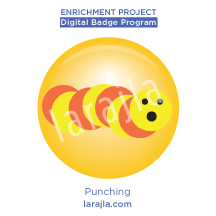 Constantly cutting shapes out with scissors can be tedious. Paper punches may look to be expensive, but as you explore all the things you can do with them, they become a better investment.
Constantly cutting shapes out with scissors can be tedious. Paper punches may look to be expensive, but as you explore all the things you can do with them, they become a better investment.
Steps
1. Different punch types.
Punches cut a shape out of paper. The way they do this varies by manufacturer. Check out a craft store, scrapbooking store or even another crafter and try the different punches available. Find out which type(s) you prefer to use.
2. Using punches.
Punches are easy to use. Slide your paper in, push / pull it and out pops your shape. You may be required to use a hard flat surface for some punches. Some of the larger punches don’t work as well and you need to stand on them. Standing offsets the pressure necessary to go through the paper due to the large cutting area. This may also be true with more intricate punches.
NOTE: Do not use intricate punches on thicker papers or materials.
3. Materials.
All paper is not created equal. Thinner papers such as mulberry paper and vellum do not punch well. Try including a sheet of copy paper to help stabilize it. Thicker papers may not fit into the punch so you may need to punch a shape from thinner paper and use it for a template.
Other materials you can cut with your punch include:
- Polymer clay
- Acrylic paint sheets
- Sticker paper
- Photographs
- Fabric (after stiffened)
- Thin aluminum cans
- Thin plastics
If you choose to experiment with these, be aware that you may destroy your punch in the process so start with one you can replace.
4. Making it work.
When you get a new punch, sometimes it is stiff and doesn’t want to work. Try these steps to get it working well.
- Work the mechanisms until they function properly without paper
- Punch wax paper (lubricant)
- Place in freezer for a while
Also, if your punch gets stuck, you can press the die area back into place or thump it gently on the floor to loosen it and knock it back into place.
5. Keep them sharp.
Keeping your punches in good working order is important. If you notice rough edges on your paper or not cutting properly, try these steps.
- Punch through wax paper
- Punch through aluminum foil
- Punch through aluminum can
6. Positioning.
To help accuracy with your punching, punch so you can see what you’re punching out. This might mean punching upside down. This is especially important if you’re punching photographs or a pattern where you want to capture a special area. Also, if you are planning on doing a craft like teabag folding, you want to make sure the pieces you punch out all match. Remove the plastic cover if your punch has one.
There are punches designed to allow you to line up and punch a consistent pattern. Find out what other ways you can help improve the positioning of your punches.
7. Keeping the scraps.
After punching out your favorite duck, you might be tempted to throw the leftover paper away. You can use the cutout for a different effect by simply putting a different colored paper behind the cutout. Use your cutouts in a craft project such as iris folding.
Beyond simple shapes
8. Stencil.
Cutouts can be used as stencils where you add ink or paint in the empty area to the paper below. You can also use the punched shape as a resist to create an area where the ink or paint around the paper actually creates the border. Try playing with punched shapes / cutouts as stencils.
9. Layering or nesting.
Punching out varying sizes of a similar shape allows you to layer different colors to create an interesting border for your images. Punch two or three different sizes of a circle, square or other shape and stack them to see the effect you can achieve.
For variety, you can also layer dissimilar shapes to create a different look.
10. Punching more than once.
When you want a shape out of a shape, like a shape in a balloon, you want to punch the inside shape first. You can then determine where you want that shape to appear in your larger shape by moving the punch around and looking at where the smaller shape will appear. Play with punching a shape (or more) inside another.
11. Assembly.
Putting multiple shapes together to make something else can be simple as circles to make a caterpillar or complicated like assembling a punched flower. Try assembling multiple shapes to create something new.
12. Shaping.
Punched shapes don’t need to remain flat. A stylus (embossing tool) can be used with a foam mat to shape the punched shapes. You can also add water to do more shaping. Experiment with various shapes.
13. Frames and edges.
Many punches are designed to create edges or frames. You can also use a corner punch to add a little interest to another shape. Create a frame using paper and punches.
14. Paper beads.
Create paper beads by punching out multiples of the same shape. Fold all of the shapes in half and glue the folds together. The inner “hole” is formed when the shapes are glued together with the folded edges together. You can use these for jewelry, ornaments, garlands, etc.
15. Keep playing.
Now that you’ve started your punching adventure, start experimenting on your own and see if you can come up with some really cool projects.
Sites to Explore
- www.ehow.com/print/how_12094162_fix-craft-punch.html
- www.paperpunchaddiction.com
- www.cutoutandkeep.net/projects/using/paper_punch
- www.whimsy-love.com/2012/09/diy-paper-punch-pendants.html
- foldingtrees.com/2008/09/pod-bead-tutorial
- www.cantstopmakingthings.com/2012/01/punch-love.html
- rubberstamping.about.com/od/supplies/a/Decorative-Hole-Punches.htm
- www.marthastewart.com/274859/craft-punch-projects/@center/276982/craft-tools-and-projects
- www.splitcoaststampers.com/gallery/showgallery.php?cat=14545
- www.bhg.com/crafts/scrapbooking/techniques/cutting/paper-punch-techniques-for-scrapbooking
To download a PDF of this badge program, click here: EP_Punching
Leave a Reply